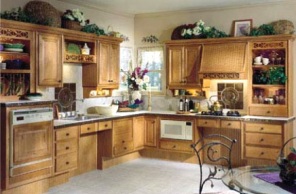Overview:
Being confined to a wheelchair and using a kitchen can be a daunting task. The common designs and layouts of kitchens create all sorts of use problems and obstacles for anyone in a wheelchair. This article provides an overview of the basics of creating an accessible
kitchen, as shown in Figure 1.

Figure 1 - Accessible kitchen design
- Doors
Access to the kitchen is as important as any other design consideration. Door opening should be at least 32 inches of completely unobstructed opening (36 inches is much better). The use of swing-free or expandable door hinges as shown in Figure 2 can help to obtain the minimum 32 inch dimension if you must have a door on the kitchen entry point.
Note: Be cautious when using any floor thresholds that, when installed are raised above the surface of the floor, as these can become a major obstacle for wheelchairs and an obstacle and safety hazard for walkers.

Figure 2 - Expandable door hinges
Note: Check with your local building department with respect to countertop mounted flip-up outlets. Many building departments will not approve their use even if they are UL and CSA approved.
- Kitchen Cabinets
- Base Cabinets:
- Countertop height - should be 32 inches from the top of the finished floor to the top of the countertop.
- Toe-kick - the toe-kick must have adequate clearance the foot rest of a wheelchair; 9 inches high, 6 inches deep, as shown in Figure 1.
- Sink & Cooktop - The sink and cooktop must be mounted in base cabinets that allow the wheelchair to position itself under the units (knee space), as shown in Figures 1 and 4.
- Sinks - should have rear drainage rather than center drainage, as shown in Figure 5. Rear drainage allows for more knee space under the sink and should still allow the installation of a garbage disposal if desired.
- Faucets - consider mounting faucets on the side of a sink, rather than the back. Use a single action faucet. Lever style handles on faucets are much easier to use than a knob style handle that must be turned.
- Water temperature - being scalded is a safety issue in the kitchen. Mixing valves
with water temperature limiting can be preset to prevent scalding. Temperature controlled mixing valves, as shown in Figure 6, should be set to a maximum temperature of 120 degrees F. or 49 degrees C.
- Cabinets - for accessibility base cabinets should have drawers rather than cabinet doors, as shown in Figure 1. The bottom of the lowest drawer should be a minimum of 9 inches from the floor.
- Drawers - should have high quality drawer slides, that open the drawer 100% and that allow the drawers to flow freely in and out when accessing them from the side, rather than the front.
D
style drawer handles or pulls are the easiest handle to grip. - Countertops - countertops with a rolled front edge can provide more comfort than a countertop with a sharp front edge.
- Kitchen Wall Cabinets:
- Height - If installed at the standard of 18 inches above the countertop, only the first shelf will be accessible for someone in a wheelchair. At 12 inches above the countertop two shelves should be accessible.
- Kitchen wall cabinet lifts, as shown in Figure 7, are available that will lower themselves for easy accessibility.
- Kitchen Flooring:
With more developers and architects being involved in the design and construction of ADA (American Disabilities Act) compliant homes, many kitchen cabinet manufacturers have created product lines that meet these requirements.
As an alternative a countertop can be used without any base cabinets, as shown in Figure 3, which provides a lot of knee space, but removes valuable storage areas.

Figure 3 - Countertop without base cabinets

Figure 4 - Under sink knee space

Figure 5 - Kitchen sink with drains mounted in back

Figure 6 - Thermostatic mixing valve
Additional information on countertop edges.

Figure 7 - Kitchen wall cabinet lift
Install flooring that has a hard surface, such as, laminate, hardwood, ceramics or natural stones. Vinyl cushion flooring, carpets, rugs or any other soft flooring should not be used.
Additional information on flooring materials and kitchen flooring.

